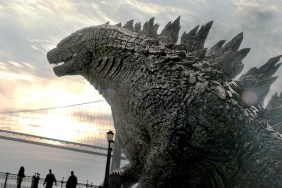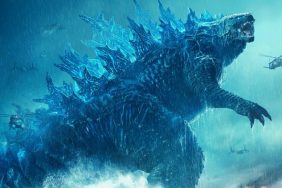There seems to be a recent attempt by American studios – exemplified by 2014’s Godzilla, Guillermo Del Toro’s Pacific Rim, the dizzying Cloverfield, and Peter Jackson’s massively self-indulgent 2005 version of King Kong – to re-inject a degree of somberness and gravity into the kaiju genre.
Kaiju – the taxonomy applied to movies that feature mutant colossi – is a genre that has previously involved smog monsters, knife-headed giants, space amoeba, and two giant Frankenstein monsters wailing on each other. To be sure, several of the Godzilla films were downright melancholy, but the genre tends to be at its strongest when it breaks free from any semblance of “adultness” and dives straight for the bonkers, half-remembered memories of 8-year-old boys. I don’t want to see people weeping for their lost families in a kaiju film. I want to see interdimensional wasps shooting lightning.
Director Jordan Vogt-Roberts (The Kings of Summer) seems to be doing his best to bring a modicum of winking daffiness back to the giant monster film with Kong: Skull Island, an Emmerichian escapade that is evocative more of post-Jurassic Park creature features of the 1990s than of any of the previous King Kong films. It’s a lightning-quick, bright, dumb, slyly silly, unapologetically clichéd pulp adventure that, despite it all, is a rip-roaring good time.

Warner Bros.
Set immediately after the Vietnam War, Kong: Skull Island follows a Ragtag Group of Adventurers™ who go on a quest to explore a South Pacific island that has just been discovered thanks to new-fangled satellite technology. There’s the conspiracy theorist scientist (John Goodman), his pretty sidekicks (Corey Hawkins and Jing Tian), a handsome, boring tracker (Tom Hiddleston), a sassy photographer (Brie Larson), a skittish company man (John Ortiz), and a wild-eyed disillusioned soldier (Samuel L. Jackson). No sooner does our team start dropping seismic-study equipment on the island does Kong show up and begin to wreak mayhem. Eventually they will be joined by a lost WWII pilot (John C. Reilly) who has been living with the placid, stone-faced natives for nearly 30 years. In sweeping defiance of previous Kong movies, the natives are mercifully free of blunt racial insensitivity. Now, they are a quiet Vietnamese tribe.
The film’s characters are paper-thin, each possessing perhaps a single character trait, and each only having maybe one minor plot point. And while the handsome milquetoast featherweight robs this film of a much-needed richness, one cannot fault Kong for efficiency. It doesn’t waste any time, slipping from one plot point to the next with a giddy eagerness, stumbling happily over its bad dialogue, knowing that the monster mayhem will have to start eventually. And when we quickly get to the monster mayhem, it’s pretty spectacular. We’ll see Kong fighting skull-headed lizard monsters and eating a giant squid, as well as a few giant spiders and a walking stick the size of a log. Luckily, standing counter to the dark-and-rainy aesthetic of most recent monster movies (seriously, I cannot see half of what is happening in Pacific Rim), the monster fights in Kong are brightly lit, well-choreographed, and fun to watch.

Warner Bros.
The Kong in this film – a somewhat convincing CGI creation – is a much larger, trimmer, more human creature than in previous Kong films. In 2005, Kong was more or less an enormous gorilla that only occasionally displayed a small deal of humanity. This Kong scowls, snarls, and comes across as a pissy club bouncer. In short, this Kong, in demeanor, is more like old-school Godzilla than like King Kong. If you’re savvy to the studio’s future plans for the monster, this may seem appropriate.
As the film progresses, its themes – however slight – begin to emerge. Kong: Skull Island is about the futility of waging war against a powerful, Civil-War-embroiled native population, who have a natural advantage in a jungle setting. Why the filmmakers chose to make a metaphor for the Vietnam War in 2017 – or rely so heavily on the structure and iconography of Apocalypse Now – is a little baffling. Perhaps the messages of peaceful monster protectors are meant to serve as an antidote to other long-running genres (superheroes, etc.) that thrive on notions of eternal conflict.
Oh yes, and be sure to stick around for the post-credits cookie. Although don’t read the actual credits, as the content of said cookie will be revealed in on-screen text.
Top Image: Warner Bros.
Witney Seibold is a longtime contributor to the CraveOnline Film Channel, and the co-host of The B-Movies Podcast and Canceled Too Soon. He also contributes to Legion of Leia and to Blumhouse. You can follow him on “The Twitter” at @WitneySeibold, where he is slowly losing his mind.







